N-BK7ベストフォームレンズ、Ø25.4 mm(Ø1インチ)、コーティング無し
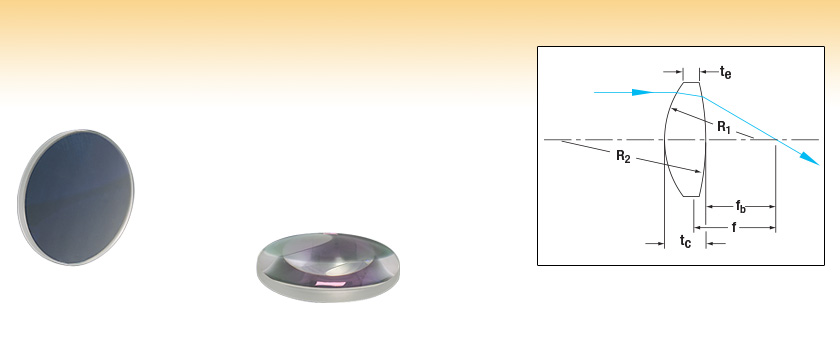
- Best Possible Performance from a Spherical Singlet
- Optimized for Infinite Conjugates
- Diffraction-Limited Performance at Small Input Diameters
- Uncoated for High-Power Applications
LBF254-200
Ø1"
LBF254-040

Please Wait
| Table 1.1 Uncoated N-BK7 Best Form Lenses | |
|---|---|
| Lens Shape | Convex/Convex |
| Substrate Material | N-BK7a |
| Design Wavelength | 587.6 nm |
| Diameter Tolerance | +0.0 mm / -0.1 mm |
| Index of Refraction | 1.5167 at Design Wavelength |
| Surface Quality | 10-5 Scratch-Dig |
| Spherical Surface Powerb | 3λ/2 |
| Spherical Surface Irregularity | λ/4 |
| Centration | <3 arcmin |
| Clear Aperture | ≥90% of Diameter |
| Focal Length Tolerance | ±1% @ Design Wavelength |
| 下の型番横の赤いアイコン(資料)をクリックすると、各製品のZemaxファイルをダウンロードいただけます。また、こちらからは当社の全てのZemaxファイルの一括ダウンロードが可能です。 |
特長
- 球面単レンズでは最も高い性能
- ハイパワー用にコーティング無しバージョンをご用意
- ハイパワー用途に使用可能
- 小さな入射径で回折限界性能
N-BK7ベストフォームレンズは、球面を利用してレンズを形成しつつ、球面収差を最小限に抑えるように設計されています。このレンズは、通常、複レンズを使用できないハイパワー用途において無限共役比で使用されています。このページでご紹介しているレンズはコーティング無しです。レンズ各面からの光の反射を抑制するために両面にARコーティングを施したベストフォームレンズもご用意しており、3種類のコーティングからお選びいただけます(Table 1.1参照)。
球面レンズでは、あらゆる焦点距離を実現するための前面および背面の曲率半径の組合せは複数あります。 表面曲率の各組合せによって、レンズによる収差の量が異なります(「グラフ」タブ参照)。 「ベストフォームレンズ」の各面の曲率半径は、レンズによる球面収差およびコマ収差が最小になるように選択されており、無限共役比での使用に最適化されています。 この工程のため、ベストフォームレンズは平凸レンズや両凸レンズより高額になりますが、高精度CNC研磨非球面レンズと比較するとかなり低価格な選択肢になります。 レンズは最小スポット径で最適化されているので、理論的には入力光のビーム径が小さくなるにつれて回折限界性能に近付きます(詳細はTable 1.2参照)。
集光用途では曲率半径が小さい(急な曲面)をコリーメート光側に向けてください。レンズキットもご用意しています。 詳細はこちらをクリックしてご覧ください。
| Table 1.2 Best Form Lenses Selection Guide | |
|---|---|
| N-BK7 | UV Fused Silica |
| Uncoated | Uncoated |
| -A Coating (350 - 700 nm) | -A Coating (350 - 700 nm) |
| - | -AB Coating (400 - 1100 nm) |
| -B Coating (650 - 1050 nm) | -B Coating (650 - 1050 nm) |
| -C Coating (1050 - 1700 nm) | -C Coating (1050 - 1700 nm) |
| Item # | Input Diameter for Diffraction-Limited Performance @ 632.8 nm | Input Diameter for Diffraction-Limited Performance @ 1064 nm |
|---|---|---|
| LBF254-040 | 5.0 mm | 6.0 mm |
| LBF254-050 | 6.0 mm | 7.0 mm |
| LBF254-075 | 8.0 mm | 9.5 mm |
| LBF254-100 | 10.0 mm | 11.5 mm |
| LBF254-150 | 13.5 mm | 16.0 mm |
| LBF254-200 | 17.0 mm | 20.0 mm |
| Quick Links to Other Spherical Singlets | ||||||
|---|---|---|---|---|---|---|
| Plano-Convex | Bi-Convex | Best Form | Plano-Concave | Bi-Concave | Positive Meniscus | Negative Meniscus |
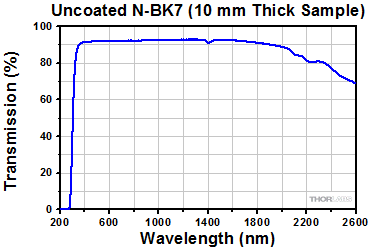
Click to Enlarge
生データをご覧になりたい場合はこちらをクリックしてください。
上の図は、RoHS準拠のBK7ガラス、N-BK7の透過率曲線を示しています。 全透過率は10 mm厚のコーティング無し試料に対して得られたもので、表面反射を含んでいます。
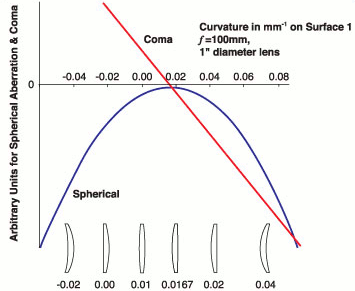
レンズの形状と
球面収差
右の図は、焦点距離100 mmのN-BK7レンズの表面曲率(c)を変化させたときのコマ収差および球面収差をプロットしたグラフです。絞りはレンズの前面に置き、視野角は±20°です。 曲率(c)と曲率半径(r)の関係は、c = 1/rで表せます。 球面収差の最小値は、ゼロコマ収差位置にほぼ一致します。 球面収差が最小となる場所でのレンズの形状は、「ベストフォーム」デザインの基本となります。
| Recommended Mounting Options for Thorlabs Lenses | ||
|---|---|---|
| Item # | Mounts for Ø2 mm to Ø10 mm Optics | |
| Imperial | Metric | |
| (Various) | Fixed Lens Mounts and Mini-Series Fixed Lens Mounts for Small Optics, Ø5 mm to Ø10 mm | |
| (Various) | Small Optic Adapters for Use with Standard Fixed Lens Mounts, Ø2 mm to Ø10 mm | |
| Item # | Mounts for Ø1/2" (Ø12.7 mm) Optics | |
| Imperial | Metric | |
| LMR05 | LMR05/M | Fixed Lens Mount for Ø1/2" Optics |
| MLH05 | MLH05/M | Mini-Series Fixed Lens Mount for Ø1/2" Optics |
| LM05XY | LM05XY/M | Translating Lens Mount for Ø1/2" Optics |
| SCP05 | 16 mm Cage System, XY Translation Mount for Ø1/2" Optics | |
| (Various) | Ø1/2" Lens Tubes, Optional SM05RRC Retaining Ring for High-Curvature Lenses (See Below) | |
| Item # | Mounts for Ø1" (Ø25.4 mm) Optics | |
| Imperial | Metric | |
| LMR1 | LMR1/M | Fixed Lens Mount for Ø1" Optics |
| LM1XY | LM1XY/M | Translating Lens Mount for Ø1" Optics |
| ST1XY-S | ST1XY-S/M | Translating Lens Mount with Micrometer Drives (Other Drives Available) |
| CXY1A | 30 mm Cage System, XY Translation Mount for Ø1" Optics | |
| (Various) | Ø1" Lens Tubes, Optional SM1RRC Retaining Ring for High-Curvature Lenses (See Below) | |
| Item # | Mount for Ø1.5" Optics | |
| Imperial | Metric | |
| LMR1.5 | LMR1.5/M | Fixed Lens Mount for Ø1.5" Optics |
| (Various) | Ø1.5" Lens Tubes, Optional SM1.5RR Retaining Ring for Ø1.5" Lens Tubes and Mounts | |
| Item # | Mounts for Ø2" (Ø50.8 mm) Optics | |
| Imperial | Metric | |
| LMR2 | LMR2/M | Fixed Lens Mount for Ø2" Optics |
| LM2XY | LM2XY/M | Translating Lens Mount for Ø2" Optics |
| CXY2 | 60 mm Cage System, XY Translation Mount for Ø2" Optics | |
| (Various) | Ø2" Lens Tubes, Optional SM2RRC Retaining Ring for High-Curvature Lenses (See Below) | |
| Item # | Adjustable Optic Mounts | |
| Imperial | Metric | |
| LH1 | LH1/M | Adjustable Mount for Ø0.28" (Ø7.1 mm) to Ø1.80" (Ø45.7 mm) Optics |
| LH2 | LH2/M | Adjustable Mount for Ø0.77" (Ø19.6 mm) to Ø2.28" (Ø57.9 mm) Optics |
| VG100 | VG100/M | Adjustable Clamp for Ø0.5" (Ø13 mm) to Ø3.5" (Ø89 mm) Optics |
| SCL03 | SCL03/M | Self-Centering Mount for Ø0.15" (Ø3.8 mm) to Ø1.77" (Ø45.0 mm) Optics |
| SCL04 | SCL04/M | Self-Centering Mount for Ø0.15" (Ø3.8 mm) to Ø3.00" (Ø76.2 mm) Optics |
| LH160CA | LH160CA/M | Adjustable Mount for 60 mm Cage Systems, Ø0.50" (Ø13 mm) to Ø2.00" (Ø50.8 mm) Optics |
| SCL60CA | SCL60CA/M | Self-Centering Mount for 60 mm Cage Systems, Ø0.15" (Ø3.8 mm) to Ø1.77" (Ø45.0 mm) Optics |
曲率が高い光学素子の取付け
当社の固定リングはマウント無しの光学素子をレンズチューブまたは光学マウント内に固定します。リングの位置固定には対応するスパナレンチを使用します。平面光学素子や曲率が低い光学素子用には黒アルマイト製の 固定リングをØ5 mm~Ø101.6 mm(Ø4インチ)まで標準品としてご用意しております。曲率が高い光学素子用には、厚みのある固定リングをØ12.7 mm(Ø1/2インチ)、Ø25.4 mm(Ø1インチ)、Ø50.8 mm(Ø2インチ)でご用意しております。
厚みのある固定リングは非球面レンズ、短焦点距離の 平凸レンズ、 コンデンサーレンズなど、曲率が高い光学素子の取り付けに使用します。右の動画のように通常の固定リングを曲率が高い光学素子に使用した場合、スパナレンチのガイドフランジが光学素子の表面に接触し、光学素子を傷つける可能性があります。また、スパナレンチと固定リングの間に隙間ができるため、固定リングが正しく締め付けられません。厚みのある固定リングは、スパナレンチが光学素子の表面に接触することなくレンズを固定させることができます。
| Posted Comments: | |
Alfonso Suances
(posted 2021-05-10 03:05:16.82) Hello.
I'm an engineering student from the University of Vigo (Spain) and I was interested in recieving information about the Damage Threshold of your N-BK7 Best Form Spherical Lenses as we are developing a laser head for a project.
Please, contact us as soon as posible.
Sincerely, Alfonso, YLohia
(posted 2021-05-12 11:03:40.0) Thank you for contacting Thorlabs. Unfortunately, we have not yet obtained conclusive damage threshold test data on these uncoated optics. tcohen
(posted 2012-04-05 18:28:00.0) Response from Tim at Thorlabs: Thank you for helping us improve our presentation! For these lenses, Zemax files are available by clicking the red icon next to the part number. Using these, theoretical focal length shifts and OPD graphs can be generated. We also provide data on diameters needed for diffraction-limited performance for our Best Form Lenses under the “Specs” tab and we are able to provide focal shift graphs for our Achromatic Doublets. I will talk to our web team to see how we can better integrate this data together within the presentation to make the performance between the two more obvious. For any immediate needs you can always contact us at techsupport@thorlabs.com where an Applications Engineer will be able to help you. user
(posted 2012-04-02 10:55:49.0) Trying to compare the best form lenses to an achromat for focusing a laser beam to the smallest possibe spot. It would be great to have some data that allows us to see when one is better than the other. technicalmarketing
(posted 2008-06-05 17:20:44.0) Response from Inge at Thorlabs: Thank you for your feedback. We removed the page break from the product table on this page. We liked the solution and reviewed several other product pages and did the same. Please let us know what you think of the solution. acable
(posted 2008-03-30 09:09:37.0) Since there are only 4 lenses on the second page can you just have them all appear on one page. |

推奨固定レンズマウント: LMR1/M
 Products Home
Products Home






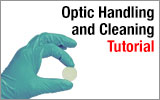
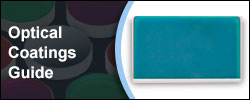
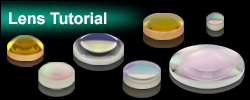
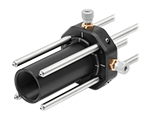
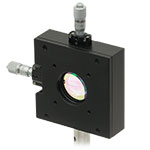


 N-BK7レンズ、コーティング無し
N-BK7レンズ、コーティング無し